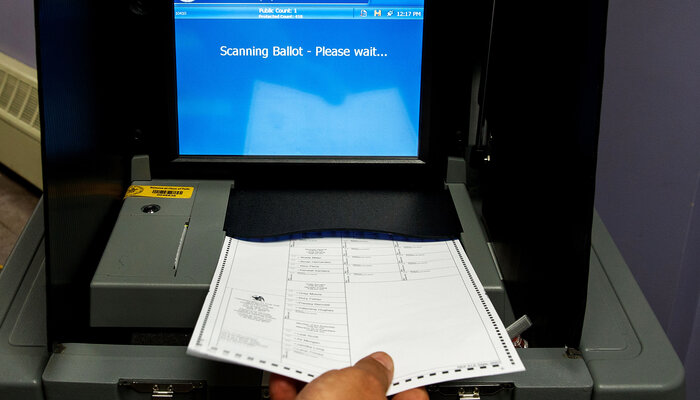In July 1971, North Carolina became the 38th state to ratify the 26th Amendment, giving 18-, 19-, and 20-year-olds across the country the right to vote.
Though in our history, the issue of who gets to cast a ballot has often been deeply fraught, the amendment had been swept along on a broad tide of bipartisan support. It was approved in the Senate 94–0 and in the House 401–19, then ratified by the states in just over three and a half months, a record. At a ceremony to mark the occasion, President Richard Nixon declared that young voters would provide a “spirit of moral courage.”
It was the Vietnam War that explained the remarkable consensus in favor of the 26th Amendment. To oppose the amendment, you had to defend the idea that young people should be drafted against their will to fight and die for their country while being denied a voice in the political process through which decisions of war and peace were made. That notion was so glaringly unjust that it was almost self-refuting. “Old enough to fight, old enough to vote” was the popular slogan.
Today, another group of Americans is being asked to sacrifice as we fight an external foe. Tens of millions of school-age kids aren’t getting an in-person education — or in some cases, any education at all — while we try to prevent the spread of Covid-19. And just as the Vietnam draft underlined the need to lower the voting age, the current plight of our schoolkids is bolstering the growing movement to lower it again, to 16.
“The pandemic has made it more clear than ever before that 16– and 17-year-olds have a stake in the game,” said Brandon Klugman, the campaign manager for Vote16USA, which is leading the effort. “Their lives are impacted enormously by decisions made by the mayor, by local governments, by school boards. And they deserve a say.”
Of course, doing classes on Zoom isn’t the same as risking one’s life in combat. But the evidence suggests that school closures are nonetheless doing serious harm to the education and socialization of American kids — with Black and brown kids suffering the most. Meanwhile, in Europe, fewer kids are out of school, which makes it clear that this wasn’t an inevitable result of a global pandemic. Rather, it was the product of a series of political decisions and governing failures — from the Trump administration’s stunning incompetence in responding to the virus, to the willingness of too many states and local governments to prioritize reopening bars, restaurants, and beaches at the expense of the need to get kids back to school. In short, the reason you can go watch the game at a sports bar but your kid might not be able to go to school is because of the choices our leaders have made.
Maybe those priorities would have been different if at least some of the people who paid the biggest price had a say in picking those leaders. Even before the pandemic hit, there was growing support for the idea of enfranchising 16– and 17-year-olds for certain elections. Since 2013, three cities in Maryland have done so for local elections, and Berkeley, California, has done so for school board elections. At least nine Massachusetts towns or cities have lowered their voting ages to 16 for local races and are waiting on approval from the state to implement the changes. A San Francisco ballot measure to do the same failed narrowly in 2016 with 48 percent support, and it is back on the ballot this year. A similar measure is on the ballot in Oakland would apply to school board elections. Bills introduced in Oregon and Washington, DC, would even have applied to state and federal elections, including the presidential race. And in recent years, several states have let 17-year-olds vote in primaries if they’ll turn 18 before the general.
In perhaps the starkest sign of momentum, an amendment introduced last year by Rep. Ayanna Pressley (D-MA) to lower the voting age to 16 for all federal elections as part of the sweeping democracy reform proposal backed by Democrats was rejected but gained 126 votes.
“When I started working on this issue in 2015, it was a huge deal if one member expressed even a tiny bit of interest,” said Klugman. “Now you have 126 members supporting it.”
The newfound energy has been driven by several factors. First, it’s a way to combat low turnout rates for young voters. Once someone picks up the habit of voting, it’s likely to stick. And high school, when people are typically home with their parents and at a stable address, may actually be a better time to pick up the habit than college, where more hurdles to voting tend to exist.
There’s also a growing body of research suggesting that 16– and 17-year-olds are perfectly capable of making rational decisions in calm, unhurried environments like the voting booth or filling out a ballot at home. That refutes the most common argument of opponents of lowering the voting age — that people under 18 aren’t mature enough to make thoughtful decisions. (That same argument, by the way, has also been used by some who want to make it harder for college students to vote, which is revealing). Indeed, we agree that 16– and 17-year-olds are mature enough to work without limits on their hours — indeed, they make up plenty of the essential workers who have kept things running during the pandemic by working in grocery stores — to pay taxes on their income, and to drive cars. Why do we draw the line at voting?
More broadly, the nature of the issues we face today as a society has spurred an increasing recognition that teens have political interests that can’t always be subsumed under those of their parents. Witness the powerful and effective movements led by high-schoolers to curb gun violence and climate change — threats that loom far larger for young people than for their parents and grandparents.
Of course, we’re unlikely to get the kind of national consensus around lowering the voting age as existed in 1971. That’s largely because, unlike back then, the partisan implications are clear: Today, young people vote Democratic by big margins, so Republicans are unlikely to back the idea. That’s one reason advocates are pursuing a state and local strategy, focused on blue states and cities.
Still, plenty of advances in our history, including on voting, have come about after a few pioneering states or local governments led the way. At a time when we’re fighting against a ruthless and organized movement to narrow voting rights, expanding who has access to the ballot would strike a powerful blow for democracy.
The views expressed are the author’s own and not necessarily those of the Brennan Center.

